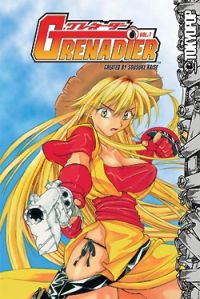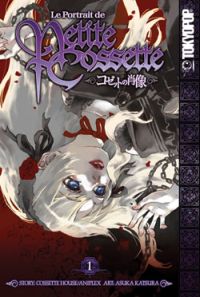RIGHT TURN ONLY!!
Sugar High
by Carlo Santos,

So, a certain publisher (who shall remain nameless to protect the innocent) has decided that they needed to update their website to look more like, I don't know, MangaSpace or something.
While their desire to build an online community is well-intentioned, did they really have to do it in the most embarrassing way possible?
GRENADIER
 Vol. 1
Vol. 1
(by Sousuke Kaise, Tokyopop, $9.99)
FROM THE BACK COVER:
"Rushuna is a golden-haired Senshi—a gunslinger who travels the land with one purpose: to make the world a peaceful place. However, her journey of nonviolence is never easy, and when she joins forces with an ambitious samurai, you better look out! Rushuna just might be forced to display her amazing gun skills—and she's got two big ones!"
PROS:
Kaise is madly in love with the action genre and lets everyone know it. Nonstop shootouts make this a breathless experience from start to finish, especially in the last two chapters, which show more confidence than the first story arc. Explosive adventure and goofy comedy are the governing principles of the series, but it's not until halfway through this volume that it reaches an appealing balance between the two. If you can get that far, and if gun-slinging action is all that matters, then maybe there's something to like about Grenadier.
CONS:
Meanwhile, everyone else is groaning at the prospect of yet another girls-with-guns series. And there is, quite literally, nothing else to see here besides a girl ... and her guns. Rushuna's sidekick is little more than comic relief and friendly target practice, and the fantasy world she's traveling through has no logical structure other than providing as many opportunities as possible to shoot things. The world of Grenadier incorporates medieval, samurai, Wild West settings and more—any excuse for a gunfight, regardless of whether or not it serves the story. Oh wait, what story? She's just going around shooting up villains. And even the act of shooting up villains is a mess—Kaise is so desperate to cram each page with action that several sequences are near unreadable. Just skim over them and assume that everyone's fighting; that's the only way to handle it. In fact, avoiding this manga entirely might be the best way to handle it.
RTO!! RATING: D
LE PORTRAIT DE PETITE COSSETTE
 Vol. 1
Vol. 1
(by Cossette House/Aniplex and Asuka Katsura, Tokyopop, $9.99)
FROM THE BACK COVER:
"Eiri works part-time at an antique shop, where he becomes obsessed with Cossette—a girl whose portrait is on sale in the store. But Cossette has a tragic story: people who own the painting have all been murdered in bizarre ways. When Cossette's spirit appears in front of Eiri, she asks him to save her...
Filled with timeless themes of love and redemption, this tragic Gothic romance is an unforgettable journey into the heart of a tortured soul."
PROS:
Ever seen a manga interpretation of M.C. Escher? Well, now you can—a shapeshifting maze of stairways is one of the striking dreamworlds that Eiri wanders through in his quest to help Cossette. At its best, this manga is a reflection of the Baroque era that the doomed young girl comes from, a luscious visual excess of frills, ornamentation, and Gothic Lolita style. Compared to the anime, it's also more coherent, capturing the ominous mood of the original but telling a more accessible story. Cossette has lost her ill-fated furniture and now she wants it back—it sounds a bit silly, but it really does help to drive the plot. Eiri's antique expertise now plays a key role, and his blood-spattered visions of Cossette's past build an essential atmosphere of horror and suspense. Once he stumbles upon a dangerous memory in Chapter 4, there's no turning back. Time to preorder Volume 2.
CONS:
Katsura's artwork, although richly detailed and ambitious, is still rough around the edges. A lot of the linework would benefit from simply using a ruler, while other aspects need more careful consideration—like the size and placement of Cossette's nose. The text isn't too thrilling, either, especially the occasional blocks of pretentious pseudo-gothic monologue. Did you know that the religious verses in Chapter 3 are lines from the Requiem Mass? It's hard to tell when the translation and adaptation manage to rob all the poetry out of it. Even though this series relies on visual spectacle and grand displays of raw emotion, little details like that are crucial as well, and right now those details could use some refining.
RTO!! RATING: B
OLD BOY

Vol. 1
(by Garon Tsuchiya and Nobuaki Minegishi, Dark Horse, $12.95)
FROM THE BACK COVER:
"Ten years ago, they took him. He doesn't know who. For ten years he has been confined in a private prison. He doesn't know why. For ten years his only contact with the outside world has been a television set and the voice of his jailers. In time, he lost himself... changed... transformed himself into something else... something hard... something lethal. Suddenly one day, his incarceration ends, again without explanation. He is sedated, stuffed inside a trunk, and dumped in a park. When he awakes, he is free to reclaim what's left of his life... and what's left is revenge."
PROS:
Forget about revenge for now—the opening volume of Old Boy is a gripping tale of survival, with our nameless hero trying to cope with modern Tokyo after his ten years in captivity. Stark flashbacks and scenes of quiet desperation prove that "gritty" doesn't have to mean "shocking and violent." Sure, he beats up some street thugs and has sex with a woman, but the protagonist's character is truly revealed in his world-weary eyes and deliberate way that he goes about his business. Incredible tension and rage are ready to be unleashed... but only once he finds his former captors, and that's the goal that keeps the story moving. Straightforward paneling and hatched shadows emphasize the stoic mood of the series—Tokyo as depicted here is not a vibrant utopia, but a concrete mess crowding around one man who plans to set things straight.
CONS:
So maybe you were expecting a hardcore action thriller... well, it's not to be found in this volume. The subject matter certainly looks like it's headed that way, but this is more of a prelude to the storm. The mounting suspense and mystery lack any resolution, and the scenes involving the "bad guy" tend to be more confusing than enlightening about the whole situation. Personal relationships are also handled poorly—after the protagonist meets a young waitress, she immediately takes him in and sleeps with him. Is this supposed to demonstrate his physical attractiveness and sexual prowess, or what? For a series that does so well introducing the main character, it's disappointingly sloppy in portraying the characters around him.
RTO!! RATING: B
Q-KO CHAN  Vol. 1
Vol. 1
(by Ueda Hajime, Del Rey, $10.95)
FROM THE BACK COVER:
"In the near-future on planet Earth, a world gone mad where never-ending war is a fact of life, Kirio is the coolest kid at school. Up in the sky, a giant robot is fighting a fleet of gunships, but the brilliant and distant Kirio is far from fazed—until the battling 'bot makes an unexpected landing in Kirio's front yard and rings the bell. But the worst threat for Kirio could be what stands on the other side of the door: an alien invader robot with the face of an adorable girl!"
PROS:
Best known as "the FLCL manga guy," Ueda distills the lessons learned from that project into a new sci-fi romp with the same manic energy. High-flying mecha battles, plush-toy-lookalike aliens, girls that transform into giant robots—what's not to like? This explosion of the imagination also carries over into the idiosyncratic art, which almost looks like a grade-schooler's work—if not for the incredible dynamism and control that underlies the edgy look. Ueda may look like he's going at it with crayons and markers, but he knows exactly what he's doing. It's a lo-fi, punk-rock take on the usually glossy world of kids piloting giant robots, and the artist is having so much fun that the excitement instantly hits anyone who so much as looks at a page.
CONS:
Why does it always have to be aliens and robots? In the hands of a less effective artist, this series would be little more than a rip-off of a rip-off, and Ueda only gets away with it because of his unique style. And even fans of the crazy-cute aesthetic might balk once they run into the bane of science fiction writing: a background scenario that makes no sense. Behind all the high-tech battle lies a government conspiracy, or something, that may or may not be clarified in the next volume (I wouldn't get my hopes up). In short, several scenes are wasted on a vague side story that only hinders the reader from reaching all the fun parts. It's clearer than the FLCL manga, but still lacking in narrative coherence.
RTO!! RATING: C+
SUGAR SUGAR RUNE

Vol. 3
(by Moyoco Anno, Del Rey, $10.95)
FROM THE BACK COVER:
"The competition to become Queen of the Magical World is heating up—and the rivalry is destroying the friendship of witch girls Chocolat and Vanilla. Tired of living in Chocolat's shadow, Vanilla has fallen under the influence of Pierre, a charming boy who is also the secret leader of a band of evil outcasts from the Magical World. When Pierre gives Vanilla a taste of the power that can be collected from angry hearts, Vanilla changes—and turns against Chocolat. Homeless and without a best friend, Chocolat finds help in both the Human and Magical worlds. Yet two problems remain: The all-important Spring Exam is coming up, and Chocolat has her own feelings for Pierre!"
PROS:
The opening chapter of this volume immediately plunges into grim territory—Vanilla turning against Chocolat and joining the Magical World's "Dark Side"—and from there it's a compelling ride through the series' best installment yet. With Vanilla now in the shadows, Chocolat finally gets a chance to show the true depth of her character, and their confrontation in the third chapter exudes a dramatic tension that only a doomed friendship can bring. In fact, Vanilla's reduced screen time makes it all the more chilling when she shows up as the good-girl-gone-bad. Even seasonal episodes like Valentine's Day focus on the girls' changing personalities rather than taking the easy way out. Anno's artwork is just as rich and complex as the story, all frills and sparkles but infused with sophistication. The characters are relentlessly stylish, the act of spellcasting is still a visual delight, and the presence of dark magic adds a new creative spark.
CONS:
Even as Moyoco Anno transforms the magical girl genre into a whirlwind of personal drama, she still makes some inevitable concessions to the school-aged readership. Some turns of plot happen way too quickly, giving the impression of a prefabricated event rather than a natural progression in the story. Chocolat getting kicked out of the house? Innocent Vanilla instantly turning evil? It might be okay for a wacky episodic romp, but something with this level of depth shouldn't have to rely on cheap plot devices. Crowded page layouts are also a continuing problem for the series; everything looks incredibly pretty but incredibly confusing. Anno clearly understands the sprawling design techniques of shoujo, but hasn't quite figured out how to make it flow.
RTO!! RATING: B+

DOGBY WALKS ALONE

Vol. 1
(by Wes Abbott, Tokyopop, $9.99)
FROM THE BACK COVER:
"YOU ARE HERE: Happyplace, the world's happiest theme park! But when chaos strikes Happyplace, park mascot Dogby, along with his loyal sidekick Snack Girl, must solve two crimes: a brazen daylight armed assault on Happyplace Theme Park and Resorts and—even more shocking—the mysterious murder of Princess, park ingenue and master of Dogby's heart! Dogby marks his territory!"
PROS:
The very idea of a dysfunctional theme park should be warning enough that we are dealing with a dangerously creative mind. Abbott does a fantastic job of skewering the Cult of Disney—urban legends, park-employee politics, and disgruntled vacationers—but he doesn't stop there. Using a hard-boiled murder mystery as his base, Abbott then proceeds to riff on just about everything else in pop culture, working his way through video game references, movie clips, and a couple of fanservice sight gags. All this, too, with a lead character that never speaks and never takes off the dog costume. You might as well have asked him to draw the entire book with his non-dominant hand. Car chases and hand-to-hand combat add a dash of action, while the monologues near the end are surprisingly heartfelt—until you remember that they're all wearing animal suits. Which just makes it even more awesome.
CONS:
The actual murder-mystery portion is held together by the thinnest of plot threads, clearly just a crutch for stringing all the parody scenes together. An absurd send-up of the genre should still have some structure to it, but this one does not: the final reveal is so convoluted that it might just be better to say, "I don't care who the killer is anymore. More jokes please!" And of course, the usual caveat applies for cultural references: humor mileage may vary depending on how many movies, TV shows and video games you know. Inconsistent artwork is another problem throughout the story; Abbott's sparse drawing style calls attention to all the little misplaced lines or curves. Also, no matter how whimsical and quirky the character designs are, they may not necessarily be appealing at first glance.
discuss this in the forum (33 posts) |